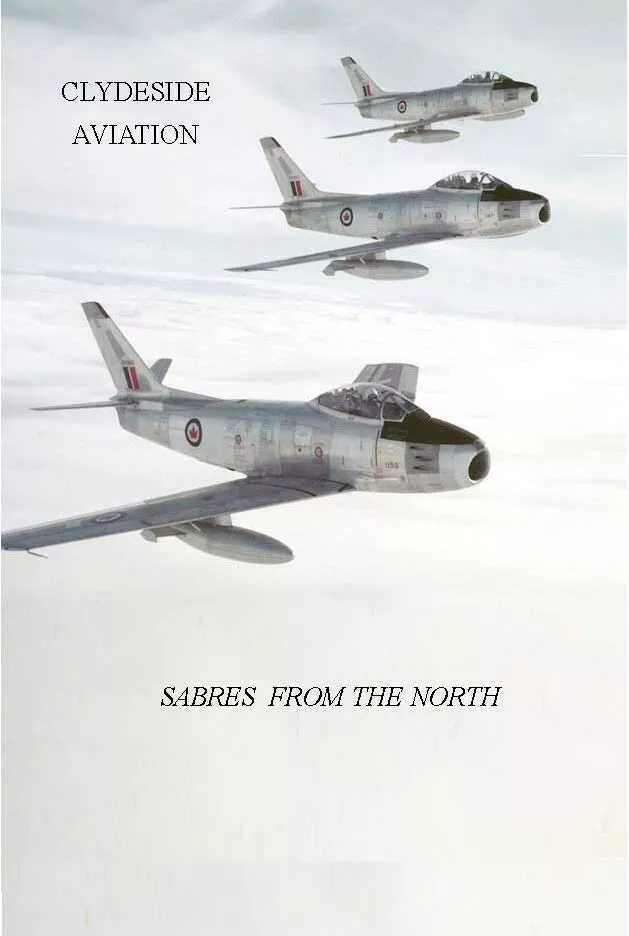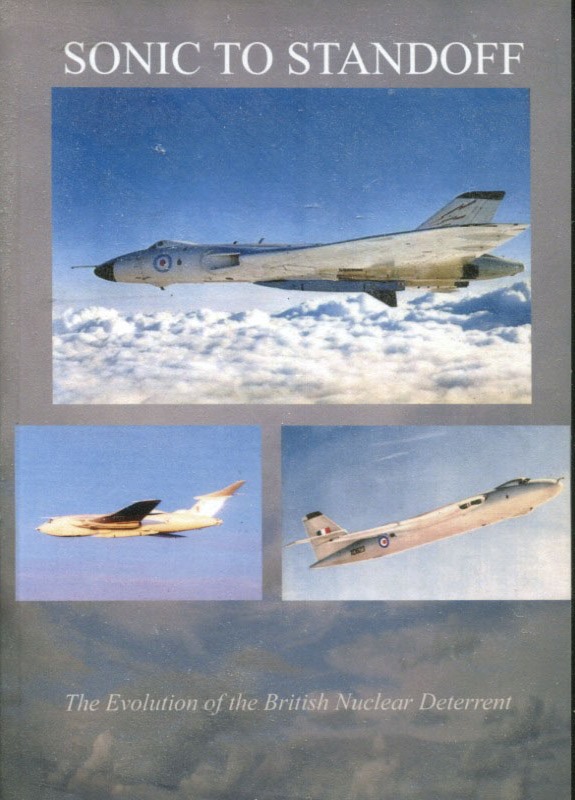Swept‑wing agility, reliable engines, and disciplined gunnery — the Sabre defined early jet‑age air combat.
Introduction: Cold War Premier Fighter
The North American F‑86 Sabre became the emblem of early jet‑age air combat. Mating a swept‑wing planform to a robust airframe and a reliable axial‑flow turbojet, the Sabre restored Allied parity over Korea and set handling and gunnery standards that influenced fighter design for a decade. Based on comprehensive research documented in Charles E. MacKay's authoritative work Sabres from the North: F-86 Sabre in RAF, RCAF, Luftwaffe Service and related sources, this Enhanced Edition presents the complete story: industrial roots, aerodynamic breakthroughs, engine integration, Korean War operations, pilot perspectives, and the type's international legacy — including Canadair and Commonwealth variants that served with the Royal Air Force and allies worldwide.
The book Sabres from the North describes the evolution and deployment of the Canadair Sabre in Royal Air Force, Royal Canadian Air Force and in NATO service-includes the West German Air Force. This comprehensive 210-page work with over 300 pictures and drawings provides detailed coverage of Sabre operations, including squadron histories of the Canadair Sabre in Royal Air Force Germany and Royal Air Force Fighter Command service. The book includes details of the Sabres being delivered over the North Atlantic in "Becher's Brook" and "Leap Frog" via Canada, Greenland, Iceland, Stornoway, Prestwick or Kinloss or Lossiemouth which is reflected in the title. This comprehensive documentation ensures that Sabre operations are properly understood within the broader context of Cold War aviation.
The Sabre's significance extends far beyond its impressive combat record. It represented a fundamental shift in fighter design philosophy, prioritizing transonic agility and reliable systems over raw speed. The aircraft's swept-wing design, combined with automatic leading-edge slats, created a fighter that performed well across a wide speed range. Understanding the Sabre's development and operations provides valuable insights into how jet technology transformed aerial combat.
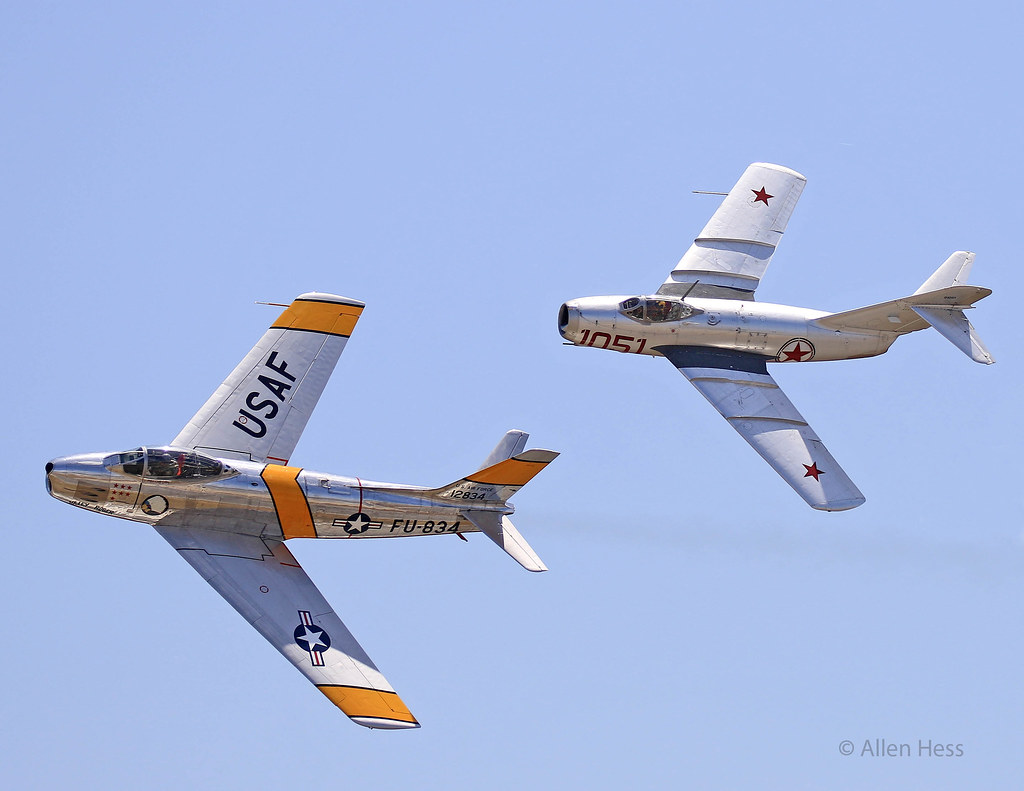
Historical Background: The Cold War Fighter Requirement
The F-86 Sabre's development occurred during the early Cold War period, when the United States needed a fighter capable of countering Soviet jet aircraft. The emergence of the MiG-15 in Korean War skies created an urgent requirement for a capable jet fighter. The Sabre's development demonstrated how rapid technological advancement could respond to operational requirements.
The book describes the evolution and deployment of the Canadair Sabre in Royal Air Force, Royal Canadian Air Force and in NATO service-includes the West German Air Force. This comprehensive coverage demonstrates how the Sabre became a cornerstone of NATO air defense. Understanding this historical context provides valuable insights into how the Sabre became operational.
The Mutual Defense Aid Program (MDAP) facilitated Sabre deployment across NATO, demonstrating how international cooperation supported air defense requirements. The comprehensive documentation of MDAP deployment ensures that Sabre's international role is properly understood.
Industrial Context and Design Lineage
North American Aviation brought wartime mass‑production experience (P‑51 Mustang) and wind‑tunnel discipline into the jet era. Early straight‑wing studies gave way to swept‑wing research informed by captured German data and domestic testing. The company's design culture prioritised clear manufacturing drawings, maintainable systems, and flight‑test feedback loops — enabling rapid block improvements in service.
North American Aviation's wartime experience with the P-51 Mustang demonstrated the company's ability to produce reliable, effective fighters. This experience informed Sabre development, ensuring that production considerations were integrated into design. The comprehensive documentation of industrial context ensures that Sabre's development is properly understood.
Early straight-wing studies gave way to swept-wing research informed by captured German data and domestic testing. This transition demonstrated how wartime technology transfer influenced post-war development. The comprehensive documentation of design evolution ensures that aerodynamic development is properly understood.
The company's design culture prioritized clear manufacturing drawings, maintainable systems, and flight-test feedback loops. This approach enabled rapid block improvements in service, demonstrating how design philosophy supported operational effectiveness. The comprehensive documentation of design culture ensures that Sabre's development methodology is properly preserved.
Aerodynamic Breakthroughs: Sweep, Slats, and Stability
The Sabre's 35‑degree swept wing delayed the onset of compressibility effects, raising critical Mach number and permitting higher transonic speeds. Automatic leading‑edge slats improved low‑speed lift and stall behaviour, enabling aggressive manoeuvring without sudden departure. The tailplane and fin were tuned to provide stable pitch authority through compressibility, while fuselage shaping managed area‑rule considerations that would be formalised later.
The 35-degree swept wing design represented a fundamental breakthrough in transonic aerodynamics. By sweeping wings backward, designers delayed the formation of shock waves that created drag increases at transonic speeds. This breakthrough enabled aircraft to operate efficiently at speeds approaching Mach 1. The comprehensive documentation of swept wing development ensures that this achievement is properly recognized.
Automatic leading-edge slats improved low-speed lift and stall behaviour, enabling aggressive manoeuvring without sudden departure. This combination of swept wings and slats created an aircraft that performed well across a wide speed range. The comprehensive documentation of slat development ensures that handling characteristics are properly understood.
The tailplane and fin were tuned to provide stable pitch authority through compressibility. As aircraft approached Mach 1, conventional elevators lost effectiveness due to shock wave formation. The Sabre's tail design provided pitch control authority throughout the transonic regime. The comprehensive documentation of flight control development ensures that these achievements are properly understood.
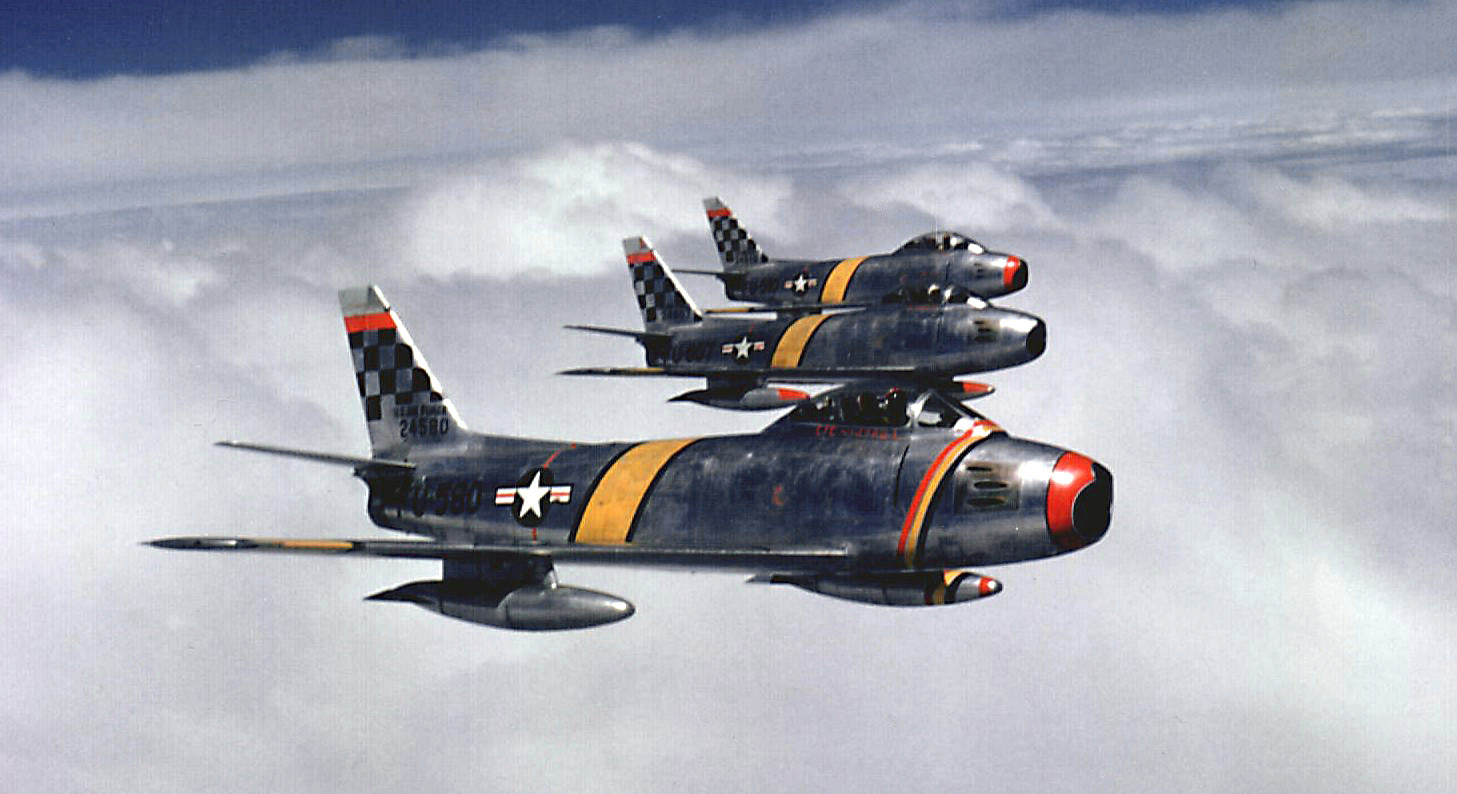
Powerplant Integration: J47, Orenda, and Avon
Most Korean‑era Sabres used the General Electric J47 axial‑flow turbojet, a durable engine with steady throttle response and maintainable hot‑section life for forward deployments. Engine installation details — intake ducting, accessory drives, and fire protection — reflected maintainability in austere conditions. Later Commonwealth "Avon Sabre" variants adopted the Rolls‑Royce Avon, demanding structural and systems adaptation but delivering higher thrust.
The book describes engine development including the J-47, Orenda and the Rolls-Royce Nene manufactured in Canada. This comprehensive coverage demonstrates how different engine types powered Sabre variants. Understanding engine development provides valuable insights into how Sabre capabilities evolved.
USAF variants used the J47‑GE‑13/27/33 family with improvements in compressor and turbine metallurgy. These improvements extended engine life and improved reliability, essential for operational deployments. The comprehensive documentation of engine improvements ensures that Sabre reliability is properly understood.
Canadair Sabre variants used Orenda engines, providing Canadian-built powerplants for NATO deployments. The Rolls-Royce Avon powered Australian Avon Sabre variants, delivering higher thrust and improved performance. The comprehensive documentation of engine variants ensures that Sabre diversity is properly recognized.
Fuel and electrics systems were reliable for winter operations, with de-icing and bleed-air management for canopy and pitot. These systems demonstrated how operational requirements influenced design. The comprehensive documentation of systems design ensures that operational considerations are properly understood.
Cockpit, Sight, and Fire Control
The Sabre's cockpit offered excellent forward visibility and ergonomics supporting energy manoeuvre tactics. The A‑1C(M) gunsight with radar ranging (APG‑30) in later blocks allowed lead‑computing solutions, improving snapshot lethality. Harmonisation practices and convergence settings were refined in theatre, with gun‑camera film closing the loop between training and combat gunnery.
The A-1C(M) gunsight with radar ranging (APG-30) represented a significant advance in fire control technology. Radar ranging provided accurate target distance information, enabling lead-computing solutions that improved gunnery accuracy. The comprehensive documentation of fire control development ensures that Sabre's combat effectiveness is properly understood.
Harmonisation practices and convergence settings were refined in theatre, demonstrating how operational experience influenced tactics. Gun-camera film closed the loop between training and combat gunnery, enabling rapid tactical evolution. The comprehensive documentation of tactical evolution ensures that Sabre's combat effectiveness is properly preserved.
The MiG‑15 Competition: First Jet vs Jet Battles
The MiG‑15 combined a 35‑degree swept wing with a powerful Klimov VK‑1 (derived from the Rolls‑Royce Nene) and heavy cannon (23/37 mm). It excelled at climb and high‑altitude performance. The Sabre countered with superior roll, turn at medium speeds, and sighting solutions; disciplined energy management evened the contest. Tactical pair work, vertical manoeuvre, and gunnery training were decisive.
The MiG-15's 35-degree swept wing and Klimov VK-1 engine (derived from the Rolls-Royce Nene) provided exceptional climb and high-altitude performance. However, the Sabre's superior roll rate, turn performance at medium speeds, and sighting solutions provided tactical advantages. The comprehensive documentation of performance comparisons ensures that combat effectiveness is properly understood.
Disciplined energy management evened the contest, demonstrating how pilot skill and tactics could overcome performance differences. Tactical pair work, vertical manoeuvre, and gunnery training were decisive factors in Sabre success. The comprehensive documentation of tactical factors ensures that combat effectiveness is properly preserved.
For comprehensive coverage of Korean War air combat, see Korean War Air Combat: The First Jet vs Jet Battles, which provides detailed analysis of F-86 vs MiG-15 combat and its influence on modern jet warfare. The comprehensive documentation of Korean War air combat ensures that these first jet battles are properly preserved.

Korean War Operations: MiG Alley Dominance
USAF Sabre wings deployed to counter MiG activity in "MiG Alley," protecting B‑29 operations and establishing local air superiority. Standard patrols involved section and flight tactics with altitude advantage and ground‑controlled intercept support. Line maintenance in winter conditions demanded rigorous cold‑weather procedures: fuel system care, hydraulic servicing, and careful engine starts to protect bearings and blades.
USAF Sabre wings deployed to counter MiG activity in "MiG Alley," protecting B-29 operations and establishing local air superiority. This deployment demonstrated how Sabre operations supported broader campaign objectives. The comprehensive documentation of Korean War operations ensures that Sabre effectiveness is properly recognized.
Standard patrols involved section and flight tactics with altitude advantage and ground-controlled intercept support. These tactics demonstrated how operational systems supported Sabre effectiveness. The comprehensive documentation of tactical procedures ensures that operational methods are properly preserved.
Pilot accounts emphasise predictable handling near buffet, recoverable stalls, and confidence in gun solutions with radar‑assisted sighting. Debriefs correlated gun‑camera footage with claimed victories, refining pursuit curves and lead computation. The Sabre community institutionalised lessons rapidly, distributing tactics notes across squadrons.
The Sabre community institutionalised lessons rapidly, distributing tactics notes across squadrons. This rapid learning demonstrated how operational experience could be quickly shared and applied. The comprehensive documentation of tactical evolution ensures that Sabre's combat effectiveness is properly preserved.
"The MiG could go uphill, but down in the medium band the Sabre would roll, point, and put tracers where the sight said. It was a pilot's airplane that rewarded smooth hands and patience."
RAF Sabre Operations: Fighter Command and Germany
The book includes squadron histories of the Canadair Sabre in Royal Air Force Germany and Royal Air Force Fighter Command service. RAF Sabre Mk.4 equipped numerous Fighter Command squadrons in the early 1950s, bridging the gap to later British types. The comprehensive documentation of RAF operations ensures that Sabre's British service is properly understood.
RAF Sabre operations demonstrated how American-designed aircraft could serve effectively in British air defense. The Sabre Mk.4's Canadair-built Orenda power and swept-wing agility bridged the gap to later British types like the Lightning. The comprehensive documentation of RAF operations ensures that Sabre's British role is properly preserved.
The book includes details of the first Sabre deployment with the carrier HMCS Magnificent and the deployment to Renfrew airport in 1951-52. These deployments demonstrated how Sabre operations extended beyond land-based operations. The comprehensive documentation of these deployments ensures that Sabre versatility is properly recognized.
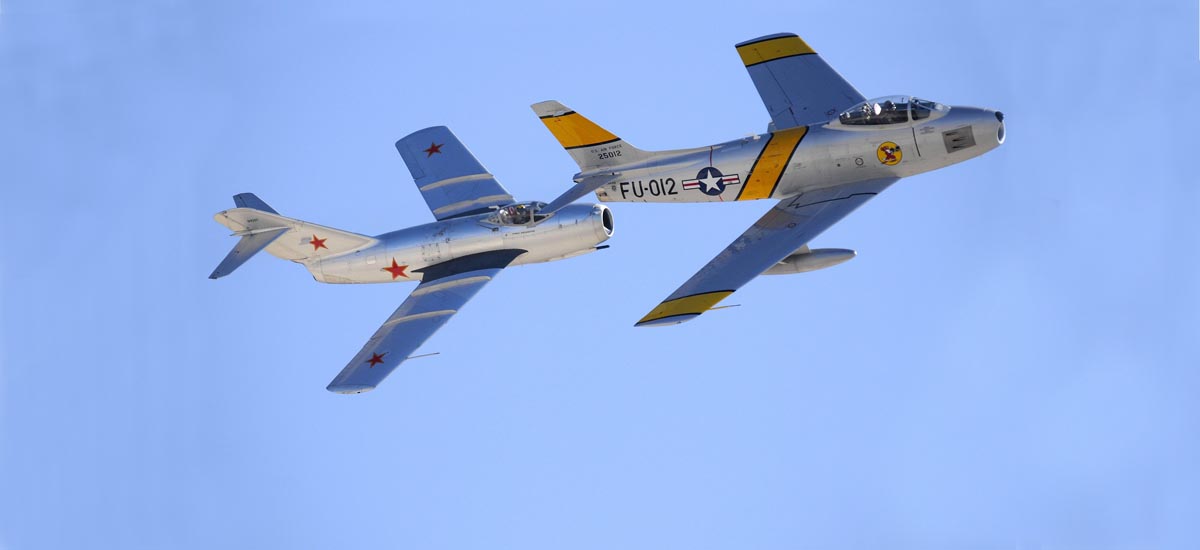
RCAF Sabre Operations: North Atlantic to Europe
The book describes the Canadair Sabre deployed in the Royal Canadian Air Force across Europe. A full description of the Sabres being delivered over the North Atlantic in "Becher's Brook" and "Leap Frog" via Canada, Greenland, Iceland, Stornoway, Prestwick or Kinloss or Lossiemouth which is reflected in the title. These flights are rarely published.
The air sea work of the SB-17G, Handley Page Hastings and the Grumman Albatross-the "Duck Buts" are included with illustrations and their control from Prestwick. This was for "Leapfrog" and "Bechers Brook." The comprehensive documentation of these operations ensures that Sabre delivery methods are properly understood.
RCAF Sabre operations across Europe demonstrated how Canadian-built aircraft contributed to NATO air defense. The comprehensive documentation of RCAF operations ensures that Sabre's Canadian role is properly preserved.
Scottish Aviation and Sabre Refurbishment
The work of Scottish Aviation at Prestwick Airport and Renfrew Airport is also fully described and illustrated with regard to USAF and RCAF refurbishment contracts for the North American F-86E and the Canadair Sabre with the Avro CF-100. The comprehensive documentation of Scottish Aviation work ensures that Sabre refurbishment operations are properly understood.
Scottish Aviation's work demonstrated how British industry supported NATO operations through aircraft refurbishment. The comprehensive documentation of refurbishment operations ensures that Sabre maintenance is properly preserved.
The involvement of Scottish Aviation, Airwork, Westland etc. is explained as well as the Sabre's fate at Church Crookham. The comprehensive documentation of these operations ensures that Sabre's complete story is properly preserved.
Variants and Block Improvements
F‑86A/E: Early combat variants; "all‑flying" tail on E improved transonic pitch control. The F-86A represented the first production Sabre, while the F-86E introduced the all-flying tail that improved transonic pitch control. The comprehensive documentation of variant development ensures that Sabre evolution is properly understood.
F‑86F: Strengthened wing; later "6‑3" hard‑edge leading‑edge extension traded low‑speed slat benefits for high‑speed performance (slatted F‑86F‑40 restored benign low‑speed traits). The F-86F represented the definitive Korean War Sabre, with improvements that enhanced combat effectiveness. The comprehensive documentation of F-86F development ensures that combat improvements are properly recognized.
Canadair Sabre (CL‑13): Orenda‑powered production for Canada and allies; RAF Sabre Mk.4 equipped numerous Fighter Command squadrons in the early 1950s. The Canadair Sabre demonstrated how licensed production supported NATO operations. The comprehensive documentation of Canadair production ensures that international production is properly recognized.
Avon Sabre: Australian CAC CA‑27 with Rolls‑Royce Avon and 30 mm cannon — substantial performance and armament uplift. The Avon Sabre demonstrated how engine upgrades could enhance Sabre capabilities. The comprehensive documentation of Avon Sabre development ensures that engine improvements are properly recognized.
International Service: NATO and Beyond
The book describes operations in the Congo with ex-RAF Sabre F-4's, in Italian service, in the United Nations, flown by Philippine pilots and in the ex-German Sabres battling in the Indo/Pakistan wars. This comprehensive coverage demonstrates how Sabre operations extended beyond NATO to global deployments.
The book includes details of the Burns-Templar agreement which paved the way for intelligence co-operation authorised at the highest political level between the United States and the United Kingdom. This comprehensive coverage demonstrates how Sabre operations supported broader intelligence cooperation. The comprehensive documentation of intelligence cooperation ensures that Sabre's role in Cold War operations is properly understood.
The West German Air Force operated Sabres as part of NATO air defense, demonstrating how Sabre operations supported German rearmament. The comprehensive documentation of German Sabre operations ensures that NATO integration is properly preserved.
Logistics, Maintenance, and Field Support
Sabre sustainment hinged on modular access to guns, engine bays, and systems. Armourers turned around gun bays rapidly with disciplined ammunition handling. Engine changes in theatre were facilitated by ground‑handling fixtures and clear manuals. Winterisation kits and hydraulic servicing practices were codified to protect reliability in freezing conditions.
Modular access to guns, engine bays, and systems enabled rapid maintenance and turnaround. This design philosophy demonstrated how maintainability supported operational effectiveness. The comprehensive documentation of maintenance procedures ensures that operational support is properly understood.
Winterisation kits and hydraulic servicing practices were codified to protect reliability in freezing conditions. These operational procedures demonstrated how environmental considerations influenced maintenance practices. The comprehensive documentation of winter operations ensures that operational challenges are properly preserved.
Training, Gunnery, and Safety
Conversion emphasised transonic handling, buffet recognition, and slat behaviour. Gunnery syllabi integrated radar‑assisted sighting and film analysis. Safety culture stressed energy awareness in the circuit with the "6‑3" wing, and stall/spin avoidance procedures for inexperienced pilots transitioning from props.
Conversion training emphasized transonic handling, buffet recognition, and slat behaviour. These training elements demonstrated how jet aircraft required different skills than piston-engine aircraft. The comprehensive documentation of conversion training ensures that pilot experiences are properly understood.
Gunnery syllabi integrated radar-assisted sighting and film analysis, enabling rapid tactical evolution. This training approach demonstrated how operational experience could be quickly incorporated into training. The comprehensive documentation of gunnery training ensures that combat effectiveness is properly preserved.
Comparison with Allied Fighters
The Sabre compared favorably with other early Cold War fighters, demonstrating superior handling characteristics and reliability. Compared to the Gloster Meteor, the Sabre's swept-wing design provided better transonic performance. Compared to the Hawker Hunter, the Sabre's earlier service entry provided valuable operational experience. The comprehensive documentation of comparisons ensures that Sabre's relative advantages are properly understood.
The book includes details of the Gloster Meteor and the Bell P-59 in RAF service, providing context for Sabre comparisons. The comprehensive documentation of these comparisons ensures that Sabre's position within early jet fighter development is properly understood.
Legacy and Influence
The Sabre validated the swept‑wing fighter for the West, influenced NATO training, and proved the value of radar‑assisted gunnery in the transonic regime. Its export footprint cemented common tactics and maintenance standards across allied air forces. Museum examples and continued flightworthy restorations keep the type alive in public memory, demonstrating the grace and authority of early jet fighters.
The Sabre validated the swept-wing fighter for the West, demonstrating that swept-wing design could provide superior performance while maintaining good handling characteristics. This validation influenced subsequent fighter development, demonstrating how successful designs establish design principles. The comprehensive documentation of Sabre influence ensures that design legacy is properly recognized.
Sabre operations influenced NATO training, establishing common tactics and maintenance standards across allied air forces. This standardization demonstrated how operational experience could be shared across nations. The comprehensive documentation of NATO influence ensures that Sabre's international role is properly preserved.
Modern Legacy and Historical Significance
The Sabre's legacy continues in modern fighter design, where swept-wing aerodynamics, reliable systems, and integrated fire control define combat aircraft capabilities. The principles established through Sabre development continue to influence fighter design. The comprehensive documentation of this legacy ensures that Sabre's historical significance is properly preserved.
Modern fighters continue to incorporate principles established by the Sabre: transonic agility, reliable systems, and integrated weapons systems. The comprehensive documentation of this continuity ensures that Sabre's influence on modern aviation is properly recognized.
Conclusion: The Sabre's Enduring Significance
The F‑86 Sabre was more than a MiG‑counter; it embodied a philosophy of controllable transonic agility, reliable systems, and trainable gunnery that defined the early jet age. Its legacy spans factories, flight lines, and doctrine manuals across the West — a benchmark for how rapid, research‑led iteration can deliver a decisive operational advantage.
The comprehensive documentation provided in Charles E. MacKay's Sabres from the North: F-86 Sabre in RAF, RCAF, Luftwaffe Service ensures that this remarkable story is preserved for future generations.
The Sabre's transformation of aerial combat demonstrated how jet technology could revolutionize military aviation. The aircraft's success in Korean War operations, combined with its international service record, established the Sabre as one of the most successful jet fighters in aviation history. The Sabre's legacy is preserved not only in historical records but in every modern fighter that benefits from the foundations established during this crucial period.
Academic Recognition and Research Value
The book is not a compendium of Wikipedia articles, this is an original work and is not an on-demand print or a compilation of search answers from web sites. This rigorous approach to research ensures factual accuracy and comprehensive coverage. The comprehensive documentation of Sabre operations creates a valuable resource for researchers studying Cold War aviation, NATO operations, and fighter development.
The book's value extends beyond individual aircraft types to provide insights into NATO operations, international cooperation, and fighter development. The comprehensive coverage of Sabre operations creates a valuable resource for understanding how jet fighters were developed and deployed during the Cold War. The detailed documentation of technical development and operational deployment ensures that the complete story of Sabre operations is properly preserved.
Further Reading and Related Works
For comprehensive coverage of the F-86 Sabre and related topics, explore these authoritative works by Charles E. MacKay:
- Sabres from the North: F-86 Sabre in RAF, RCAF, Luftwaffe Service — Comprehensive 210-page work with over 300 pictures and drawings, describing the evolution and deployment of the Canadair Sabre in Royal Air Force, Royal Canadian Air Force and in NATO service-includes the West German Air Force, including squadron histories, North Atlantic delivery flights ("Becher's Brook" and "Leap Frog"), Scottish Aviation refurbishment work, RAF/RCAF operations, and international deployments
- Korean War Air Combat: The First Jet vs Jet Battles — Detailed analysis of F-86 vs MiG-15 combat
- Jet Age Aviation: Cold War Development — How jet technology evolved after World War II
- English Electric Lightning: Britain's Supersonic Interceptor Revolution — A later British interceptor shaped by QRA doctrine
- Sonic to Standoff: The Evolution of the British Nuclear Deterrent — Evolution from transonic gunfighters to missile-armed interceptors
Related Articles
- Korean War Air Combat: The First Jet vs Jet Battles — Campaign context and sortie patterns
- Jet Age Aviation: Cold War Development — Post-war jet evolution
- English Electric Lightning: Britain's Supersonic Interceptor Revolution — A later British interceptor
References
- Royal Air Force Museum — Aircraft Collection — Royal Air Force Museum
- Imperial War Museums — Aviation History Articles — Imperial War Museums
- FlightGlobal Archive — FlightGlobal
